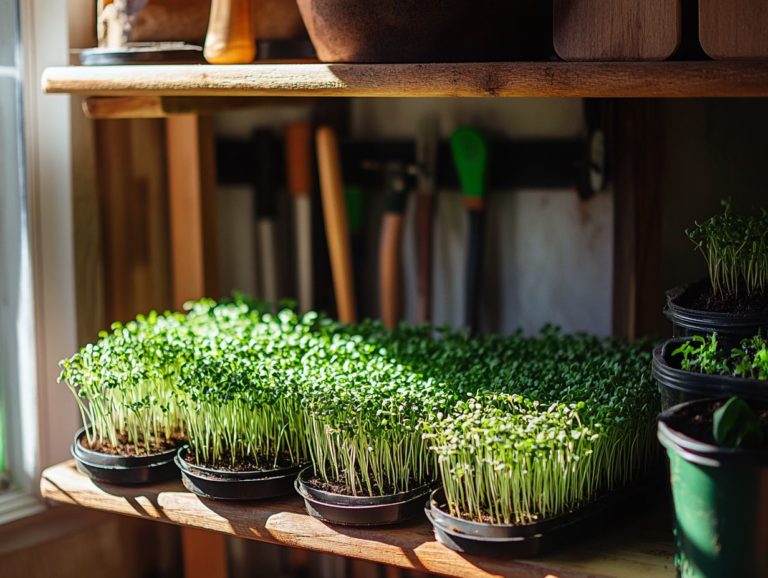How to Grow Microgreens for a Fresh Salad
Microgreens are tiny, nutrient-dense plants. They can elevate your culinary creations and provide remarkable health benefits.
In this article, you ll explore the world of microgreens. Discover their nutritional value and how easy it is to grow them at home.
You ll uncover popular varieties and the essential supplies you ll need. There s also a comprehensive step-by-step guide to planting and maintaining these vibrant greens.
Plus, you ll find expert tips on harvesting. Enjoy creative ideas for incorporating microgreens into your salads. Get ready to transform your meals with the fresh flavors of homegrown microgreens!
Contents
- Key Takeaways:
- Benefits of Growing Microgreens
- Choosing the Right Microgreens to Grow
- Supplies and Equipment Needed
- Step-by-Step Guide to Growing Microgreens
- Preparation, Planting, and Maintenance
- Harvesting and Using Microgreens
- Best Practices for Harvesting and Storage
- Recipes and Ideas for Using Microgreens in Salads
- Frequently Asked Questions
Key Takeaways:
- Microgreens are young vegetable greens that are packed with nutrients and can easily be grown at home.
- Choose popular microgreen varieties like kale, arugula, and radish for their unique flavors and versatility in salads.
- All you need to grow microgreens are basic gardening tools, seeds, soil, and a sunny spot.
What are Microgreens?
Microgreens are delightful little edible greens you harvest just after the first true leaves appear. They re bursting with flavor and nutrients.
Varieties such as broccoli sprouts, kale, and arugula are gaining recognition for their health benefits and culinary versatility. They are essential in modern home and indoor gardening.
They don t just top your salads; they elevate w wraps, sandwiches, and Buddha Bowls. Microgreens infuse your meals with a refreshing burst of taste and nutrition.
You can easily grow these nutrient-packed greens from seeds like mustard, beets, and radishes. They thrive in small containers or even on your kitchen windowsill.
The growth process is straightforward just a few days of care with soil or a hydroponic setup (growing plants without soil), and you re on your way.
Cultivating microgreens is an excellent way to embrace sustainable gardening. They require minimal water and space yet deliver maximum nutritional value.
Rich in vitamins and antioxidants, these petite plants not only add a vibrant splash of color to your dishes but also play a significant role in a healthy diet. They are a beloved choice for both chefs and home cooks.
Benefits of Growing Microgreens
Growing microgreens provides a wealth of benefits that go far beyond their delightful flavors. They serve as a remarkable asset for both health and sustainability.
These nutrient-dense greens boast impressive concentrations of vitamins, antioxidants, and health-promoting properties. They can significantly bolster your overall wellness, including potential cancer-fighting capabilities.
They thrive in limited spaces, making them perfect for small-space gardening. You can embark on a DIY gardening project in your kitchen windowsill or any indoor setup.
Nutritional Value and Convenience
Microgreens are not just a burst of flavor; they re also celebrated for their remarkable nutritional benefits. This makes them a perfect choice for health-conscious individuals.
These vibrant greens, such as broccoli, kale, and radish, are brimming with vitamins A, C, E, and K. They also contain essential minerals like calcium and magnesium.
Their high chlorophyll content and rich antioxidants offer a multitude of health benefits. These range from reducing inflammation to enhancing immune function.
Incorporating microgreens into your diet can improve nutrient absorption and promote better digestion. This is thanks to their prebiotic properties that nurture healthy gut bacteria.
With their culinary versatility, adding these nutrient-dense greens to your everyday meals is effortless. It’s an exciting way to elevate flavors while prioritizing your health.
Choosing the Right Microgreens to Grow
Choosing the right microgreens to cultivate can truly elevate both your culinary adventures and gardening success. Each variety presents unique flavors and health benefits, enriching your dishes in delightful ways.
Consider popular options like broccoli sprouts, radish, cilantro, and fenugreek. Each brings its distinct taste that enhances everything from salads to wraps. By adopting container gardening or small-space techniques, you can successfully grow these vibrant greens, ensuring a continuous supply of fresh vegetables right from your kitchen windowsill. To maximize growth, learn how to use grow lights for microgreens.
Popular Varieties and Their Uses

Among the myriad of microgreens available, popular varieties like broccoli, arugula, radish, and basil truly stand out for their unique flavors and culinary versatility. These microgreens can transform various dishes, enhancing not just the taste but also the health benefits of your salads, sandwiches, and wraps. Plus, they add a vibrant, fresh appearance that elevates your meals.
Broccoli microgreens have a slightly peppery taste and are a fantastic choice for boosting your intake of vitamins A, C, and K. Arugula microgreens deliver a zesty kick, making them ideal for sprucing up pizzas or grain bowls. Radish microgreens offer a crunchy, spicy note that pairs beautifully with seafood or as a topping for tacos. Basil microgreens infuse a sweet, aromatic essence that enhances your pasta recipes or fresh pestos. For optimal growth, consider learning how to rotate crops for microgreens.
Each of these microgreens not only contributes its unique flavor but also enriches your dishes with essential nutrients, proving their invaluable worth in any culinary endeavor.
Supplies and Equipment Needed
To successfully cultivate microgreens, equip yourself with the right supplies and equipment for a rewarding experience. Key items include:
- Growing trays
- Sprouting containers
- Top-notch gardening tools for planting and maintenance
Selecting the right growing medium is vital for fostering healthy plant growth. Effective water management and diligent watering practices will further ensure that your indoor gardening endeavors yield optimal results.
Essential Tools and Materials
Essential tools and materials for growing microgreens include items that enhance the sprouting process and promote healthy growth. Start with a suitable growing medium, like soil or coconut coir, along with tools for efficient water management to ensure consistent daily watering tailored to the needs of these nutrient-packed microgreens.
Using trays with drainage holes is crucial; they help prevent waterlogging, which can lead to mold or disease, thus protecting your delicate plants. Measuring devices, like misting bottles or watering cans with fine nozzles, allow you to hydrate precisely, fostering optimal germination and growth rates.
Lightweight grow lights can significantly boost photosynthesis during darker periods, ensuring your microgreens receive the light they need. By utilizing these tools and materials, you can streamline the cultivation process and set the stage for a bountiful harvest. If you’re interested in learning more, check out this guide on how to grow microgreens in your kitchen rich in flavor and nutrition.
Step-by-Step Guide to Growing Microgreens
Get ready to dive into a fun journey of growing your own microgreens! This guide will take you through the essential stages, from preparation and planting to ongoing maintenance, enabling you to cultivate these nutrient-rich microgreens right in your home or on your kitchen windowsill.
Whether you choose container gardening or growing trays, each meticulous step is designed to help you maximize health benefits and elevate the flavor of your microgreens, especially when you learn how to grow microgreens in a small space.
Preparation, Planting, and Maintenance
Preparing, planting, and maintaining microgreens is essential for vibrant growth. Start with your choice of the right growing medium and seeds. Adequate sunlight exposure is crucial for optimal growth. Maintain a consistent watering schedule to support sprouting and promote the overall health of your plants.
Choosing high-quality seeds bred for microgreens is fundamental. They germinate quickly and offer robust flavors. Your choice of growing medium is equally important; options like potting soil, coconut coir, or a hydroponic mat create the perfect environment for young seedlings. For those interested in cultivating these greens throughout the year, exploring techniques for growing microgreens year-round can be beneficial.
When planting, space the seeds properly to give them room to flourish. Aim for a planting depth of about a quarter of an inch. After planting, maintain a balance of light whether from natural sunlight or grow lights and stick to a scheduled watering routine to prevent over-saturation or drought. For more detailed techniques, check out how to use hydroponics for microgreens, as both are critical for cultivating healthy microgreens.
Harvesting and Using Microgreens

Harvesting microgreens is a gratifying experience. You gain fresh greens that elevate your meals while exploring an array of creative culinary possibilities.
Employ the right harvesting techniques to preserve maximum flavor and nutritional benefits. These delicate greens enhance fresh salads, add vibrancy to sandwiches, and elevate the flavor profile of various dishes. If you’re interested in growing them yourself, check out this guide on how to grow microgreens in small containers, making them a versatile ingredient in your kitchen.
Best Practices for Harvesting and Storage
Keep your microgreens fresh and flavorful with proper harvesting and storage. Use sharp scissors for a clean cut during harvesting. This minimizes damage and enhances their flavor.
Timing is crucial. Harvest microgreens just before they reach maturity for the best flavors and colors. Many experts recommend cutting them early in the morning when moisture levels are high, ensuring maximum crispness. For those looking to enhance their growing techniques, a step-by-step guide to sowing microgreens can be incredibly helpful. After harvesting, transfer them promptly to a cool environment to preserve freshness and maintain delightful taste.
To protect their integrity, layer damp paper towels between the microgreens. This absorbs excess moisture and creates an ideal balance between hydration and air circulation, keeping your greens in peak condition. If you’re new to gardening, consider learning how to start a microgreen garden for beginners for more tips.
Recipes and Ideas for Using Microgreens in Salads
Incorporating microgreens into your salads elevates the flavor profile and infuses your meals with a nutrient boost. From vibrant mixed greens to zesty radish microgreens, the flavors and textures they offer transform a simple salad into an extraordinary culinary experience, presenting endless opportunities for creativity in your kitchen.
Maximize their potential by pairing these tiny greens with complementary ingredients like creamy avocados, tangy citrus fruits, or crunchy nuts. Each microgreen variety, whether it’s the delicate peppery notes of arugula or the mild sweetness of pea shoots, enhances the taste and visual appeal of your salad. For more tips on optimizing your harvest, check out this guide on how to maximize yields from microgreens.
Packed with vitamins, minerals, and antioxidants, these little wonders turn any salad into a nutrition powerhouse. Explore these vibrant options to discover that incorporating such delightful ingredients paves the way for a fun and flavorful journey toward healthier eating.
Frequently Asked Questions
What are microgreens and why should I grow them for my salad?
Microgreens are young vegetable greens harvested after the first leaves sprout. They are packed with nutrients and have a more intense flavor compared to their mature counterparts, making them a great addition to any salad.
Start your microgreen journey today for a tasty and healthy boost to your meals!
What do I need to grow microgreens?

To grow microgreens, you’ll need a container, potting soil, seeds, water, and a light source. For convenience, consider using a grow kit designed specifically for microgreens.
How do I prepare the container for microgreens?
Fill the container with potting soil and moisten it with water. Ensure the soil is level and not too compact, leaving about an inch of space at the top for the seeds.
Which seeds are best for microgreens?
Broccoli, kale, arugula, and radish seeds work well for microgreens. Look for seeds labeled specifically for microgreens to guarantee the best growth.
How long does it take to grow microgreens?
Growing time varies by seed type, but it typically takes 1-2 weeks. Harvest your microgreens once they develop their first true leaves!
How do I harvest and store my microgreens?
Use clean scissors to snip the microgreens just above the soil level. Rinse them gently, pat them dry, and store in an airtight container in the refrigerator. They can last up to a week when stored properly.






